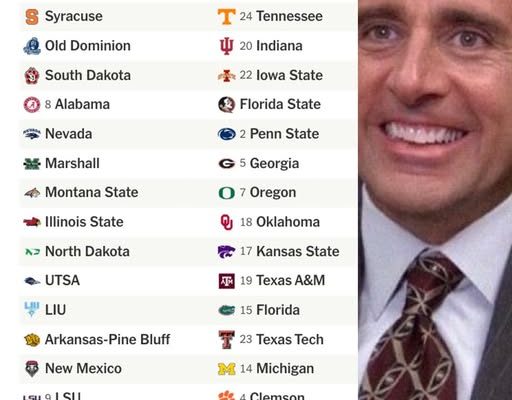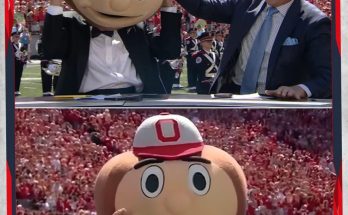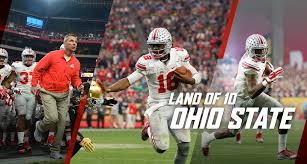“We made it A full day of college football is finally here” is a phrase that resonates deeply with fans across the nation. For months, anticipation has been building. From spring practices to summer workouts, from preseason predictions to heated debates on social media, the wait for the return of college football feels like an eternity. Yet when that first full day finally arrives, when the early morning sun rises and the countdown to kickoff is no longer measured in weeks or days but in hours and minutes, the excitement is unmatched. It is not just the return of a sport; it is the revival of a tradition that ties generations together, fuels rivalries, and sparks conversations in homes, on campuses, and across entire communities.
The full day slate of college football is unlike any other sports experience. It begins early with tailgaters setting up hours before the first game, with grills fired up and flags waving proudly in parking lots from Austin to Columbus to Tuscaloosa. Fans wear their school colors with pride, bringing out jerseys, face paint, and gear that has been tucked away since last season. Every detail is part of a ritual, from the songs blasting out of speakers to the chants that echo through campus quads. The atmosphere is less about watching a game and more about living a full-day experience that reflects the culture and identity of the schools. For many, the morning feels like Christmas, with the gift being a lineup of nonstop football stretching well into the night.
The day’s energy builds with the opening kickoff of the first games, often featuring non-conference matchups that set the stage for how teams will measure up this season. In these early contests, fans get their first real look at highly touted freshmen, transfers who have switched schools, or coaches making their debuts on new sidelines. Every pass, run, and defensive stop feels magnified because it has been so long since the last competitive snap. Analysts may point out that early-season games are about shaking off rust and figuring out lineups, but for fans, it’s already a matter of pride and identity. Winning the first game can build momentum and confidence, while losing early often sparks panic and doubt, even if the season is still young.
As the day progresses, the intensity rises. The noon games shift into the afternoon, where traditional powerhouses usually take the field. These games often feature marquee matchups that draw national attention, pitting top-ranked teams against one another in contests that could have playoff implications down the road. For example, when a No. 1 seed faces off against a top-five rival, the stakes are enormous, even in the opening weeks. Every touchdown or turnover can alter the trajectory of a season. Fans watching from home flip between channels, trying to catch every dramatic moment, while those lucky enough to be in stadiums witness the kind of passion that can only be found in college athletics.
The late afternoon brings another wave of action. For fans of the SEC, Big Ten, ACC, Big 12, or Pac-12, this is prime time for conference bragging rights and for showcasing dominance to the rest of the country. The roar of crowds in stadiums such as the Horseshoe in Ohio, Bryant-Denny in Alabama, or Memorial Stadium in Clemson is deafening, creating an atmosphere so intense that even television broadcasts can barely capture it. Students, alumni, and casual fans alike unite in cheering for their team, creating memories that often outlast the games themselves.
But the true beauty of a full day of college football is that it doesn’t end when the sun goes down. As evening approaches, fans settle in for the night games, often featuring West Coast teams or late-showdowns in major conferences. These games extend the joy of the day, keeping fans locked in until midnight or later. There is something uniquely satisfying about watching a nail-biting game under the lights, where the stakes feel higher and the atmosphere more electric. The sight of a stadium glowing against the night sky, with fans waving towels and bands playing fight songs, captures the essence of college football at its finest.
Throughout the day, storylines emerge that fuel discussions long after the games end. Upsets become legendary, with underdog teams shocking ranked opponents and shaking up the standings. Star players begin to make their case for the Heisman Trophy with highlight-reel performances. Coaches are praised for bold decisions or criticized for questionable calls. And fans, whether celebrating victory or lamenting defeat, find themselves emotionally invested in every outcome. College football is unique in how much each game matters; with only a limited number of opportunities in a season, every win or loss carries weight. Unlike professional leagues where teams play dozens of games, a single Saturday in college football can shape the entire postseason landscape.
The social aspect of a full day of college football cannot be ignored. Families gather in living rooms, friends host watch parties, and alumni reunite on campus, all centered around the games. Social media buzzes constantly, with fans sharing reactions, memes, and hot takes about every big play. Platforms like X (formerly Twitter) turn into real-time sports bars, where fans can interact with each other across the country, celebrating wins and commiserating over losses together. The shared experience amplifies the joy of the day, creating a sense of belonging to a much larger community.
Economically, a full day of college football also has major implications. Local businesses around college towns thrive on game days, with restaurants, bars, and hotels packed with fans. The financial boost that comes from a home game weekend is significant, especially in towns where the university is the heart of the community. Television networks also reap the rewards, as millions of viewers tune in, driving ratings and advertising revenue. The sheer scale of the event goes beyond just sports—it impacts culture, economy, and community on a national level.
One of the most special aspects of college football is its diversity. With so many teams, conferences, and traditions, no two experiences are the same. In one part of the country, fans may be watching a Big Ten heavyweight clash in freezing weather, while in another, the Pac-12 might be showcasing a shootout under palm trees. This variety ensures that there is always a story to follow, always a team to root for or against, and always a reason to keep watching. The traditions, whether it’s singing a fight song, waving a particular flag, or performing a special entrance ritual, add to the identity of each program, making every matchup unique.
For players, this day is a dream realized. Many have worked their entire lives for the chance to play on this stage, under the bright lights, with millions watching. It is an opportunity to prove themselves, to honor their schools, and in many cases, to begin building a legacy that could lead to professional careers. The pressure is immense, but so too is the reward. For seniors, every moment carries extra weight, knowing this could be their final season to leave a mark. For freshmen, it is the start of a journey filled with possibilities.
Fans often describe the first full day of college football as a reset button for the year. Regardless of what challenges life may bring, that Saturday offers an escape, a celebration, and a reminder of the joy that sports can bring. The ups and downs of the games mirror life itself—moments of triumph, heartbreak, resilience, and community. The chants, the cheers, the marching bands, the fireworks—all combine to create something magical, something that is hard to replicate in any other sport.
When the final whistle blows on the last game of the day, fans may feel exhausted, but it is a satisfying exhaustion. The hours spent watching, cheering, and experiencing the highs and lows create memories that last long after the day is done. And even as fans head to bed in the early hours of the morning, they know that the season has only just begun. The excitement will continue each week, building toward rivalries, championships, and ultimately the playoff. But there is something uniquely special about that very first full day, when everything feels new, fresh, and filled with possibility.
So when fans exclaim, “We made it A full day of college football is finally here,” it is not just about the games themselves. It is about the collective celebration of tradition, passion, and community. It is about generations of fans passing down love for their teams, about players chasing dreams, and about schools showcasing their pride on the national stage. It is about the smell of barbecue smoke in parking lots, the sight of marching bands taking the field, and the sound of tens of thousands of voices united in song and cheer. It is about the return of something bigger than sports, something that defines Saturdays for millions of people every fall. And for those who live and breathe college football, there is no better feeling than knowing the wait is finally over.



